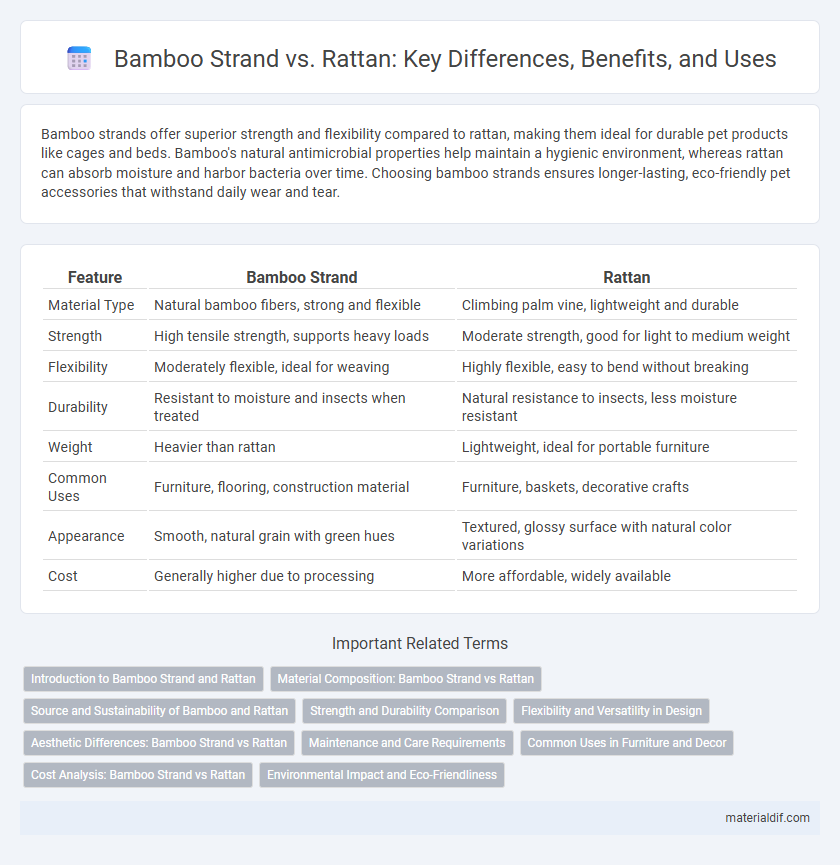Bamboo strands offer superior strength and flexibility compared to rattan, making them ideal for durable pet products like cages and beds. Bamboo's natural antimicrobial properties help maintain a hygienic environment, whereas rattan can absorb moisture and harbor bacteria over time. Choosing bamboo strands ensures longer-lasting, eco-friendly pet accessories that withstand daily wear and tear.
Table of Comparison
| Feature | Bamboo Strand | Rattan |
|---|---|---|
| Material Type | Natural bamboo fibers, strong and flexible | Climbing palm vine, lightweight and durable |
| Strength | High tensile strength, supports heavy loads | Moderate strength, good for light to medium weight |
| Flexibility | Moderately flexible, ideal for weaving | Highly flexible, easy to bend without breaking |
| Durability | Resistant to moisture and insects when treated | Natural resistance to insects, less moisture resistant |
| Weight | Heavier than rattan | Lightweight, ideal for portable furniture |
| Common Uses | Furniture, flooring, construction material | Furniture, baskets, decorative crafts |
| Appearance | Smooth, natural grain with green hues | Textured, glossy surface with natural color variations |
| Cost | Generally higher due to processing | More affordable, widely available |
Introduction to Bamboo Strand and Rattan
Bamboo strand is an engineered fiber derived from bamboo plants, known for its strength, flexibility, and eco-friendly properties, making it a popular choice in sustainable construction and furniture design. Rattan, a naturally growing vine, is valued for its lightweight and pliable characteristics, commonly used in traditional wickerwork and handcrafted furniture. Both materials offer renewable alternatives to hardwood, but bamboo strand provides enhanced uniformity and durability through its manufacturing process.
Material Composition: Bamboo Strand vs Rattan
Bamboo strands consist primarily of cellulose fibers bound with natural lignin, providing exceptional tensile strength and flexibility ideal for construction and crafting. In contrast, rattan is composed of solid vascular bundles within a fibrous matrix, offering superior pliability and durability for furniture making. The distinct material compositions influence their respective applications, with bamboo strands excelling in lightweight structural uses and rattan favored for intricate weaving and ergonomic designs.
Source and Sustainability of Bamboo and Rattan
Bamboo is a fast-growing grass primarily sourced from Asia, renowned for its regenerative capabilities that make it highly sustainable and eco-friendly. Rattan, derived from tropical climbing palms found mainly in Southeast Asia, is slower to regenerate and often harvested through destructive methods, impacting forest ecosystems. Bamboo's rapid growth and ability to absorb carbon dioxide efficiently position it as a superior sustainable material compared to rattan, which faces challenges in sustainable sourcing and habitat conservation.
Strength and Durability Comparison
Bamboo exhibits superior strength and durability compared to rattan due to its dense, fibrous structure and high tensile strength, making it highly resistant to cracking and splitting under pressure. Rattan, while flexible and lightweight, tends to be less robust and more susceptible to wear and damage from prolonged exposure to moisture and heavy use. Bamboo's natural hardness and longevity make it a preferred material for construction and furniture that require lasting structural integrity.
Flexibility and Versatility in Design
Bamboo's natural flexibility allows it to be easily bent and shaped without breaking, making it highly versatile in design applications ranging from furniture to architecture. Unlike rattan, which is more rigid and prone to cracking under stress, bamboo offers superior durability and elasticity, enabling intricate weave patterns and structural forms. Its lightweight yet strong properties contribute to its widespread use in contemporary and traditional crafts where adaptive design is essential.
Aesthetic Differences: Bamboo Strand vs Rattan
Bamboo strands exhibit a smooth, sleek texture with a natural light yellow hue that darkens over time, creating a minimalist and modern aesthetic well-suited for contemporary designs. Rattan features a more fibrous, textured surface with a warm tan to reddish-brown color, offering a rustic and organic appearance that enhances traditional or bohemian styles. The visual contrast between bamboo's linear grain and rattan's woven pattern emphasizes the distinct decorative appeal of each material in furniture and interior design.
Maintenance and Care Requirements
Bamboo strands require minimal maintenance, needing only occasional cleaning with a damp cloth and protection from prolonged moisture to prevent mold and rot. Rattan demands more frequent care, including regular dusting and periodic application of oil or varnish to maintain flexibility and prevent cracking. Both materials benefit from avoiding direct sunlight to extend their lifespan and preserve their natural appearance.
Common Uses in Furniture and Decor
Bamboo strands are widely used in furniture and decor for their strength, flexibility, and sustainability, making them ideal for lightweight chairs, tables, and decorative screens. Rattan, known for its hollow, vine-like structure, is commonly crafted into woven furniture such as baskets, loungers, and intricate chair frames due to its natural bendability and durability. Both materials are popular in eco-friendly interior design, but bamboo strands offer a more rigid and modern aesthetic, while rattan provides a classic, rustic appeal.
Cost Analysis: Bamboo Strand vs Rattan
Bamboo strand products typically offer a more cost-effective solution compared to rattan, owing to bamboo's faster growth cycle and higher yield per hectare, which reduces raw material expenses. Rattan requires more intensive harvesting and processing methods, leading to higher labor costs and overall price points. This cost difference makes bamboo strand an attractive option for manufacturers and consumers seeking durable, eco-friendly materials at a lower price.
Environmental Impact and Eco-Friendliness
Bamboo strands have a significantly lower environmental footprint compared to rattan due to faster growth rates and higher carbon sequestration capacity, making bamboo a more sustainable material choice. Bamboo cultivation requires minimal pesticides and water, reducing soil degradation and promoting biodiversity, while rattan harvesting often involves deforestation and habitat disruption. The renewable nature of bamboo fibers and their biodegradability further enhance bamboo's eco-friendliness compared to the slower-regenerating rattan vines.
Bamboo strand vs Rattan Infographic

 materialdif.com
materialdif.com